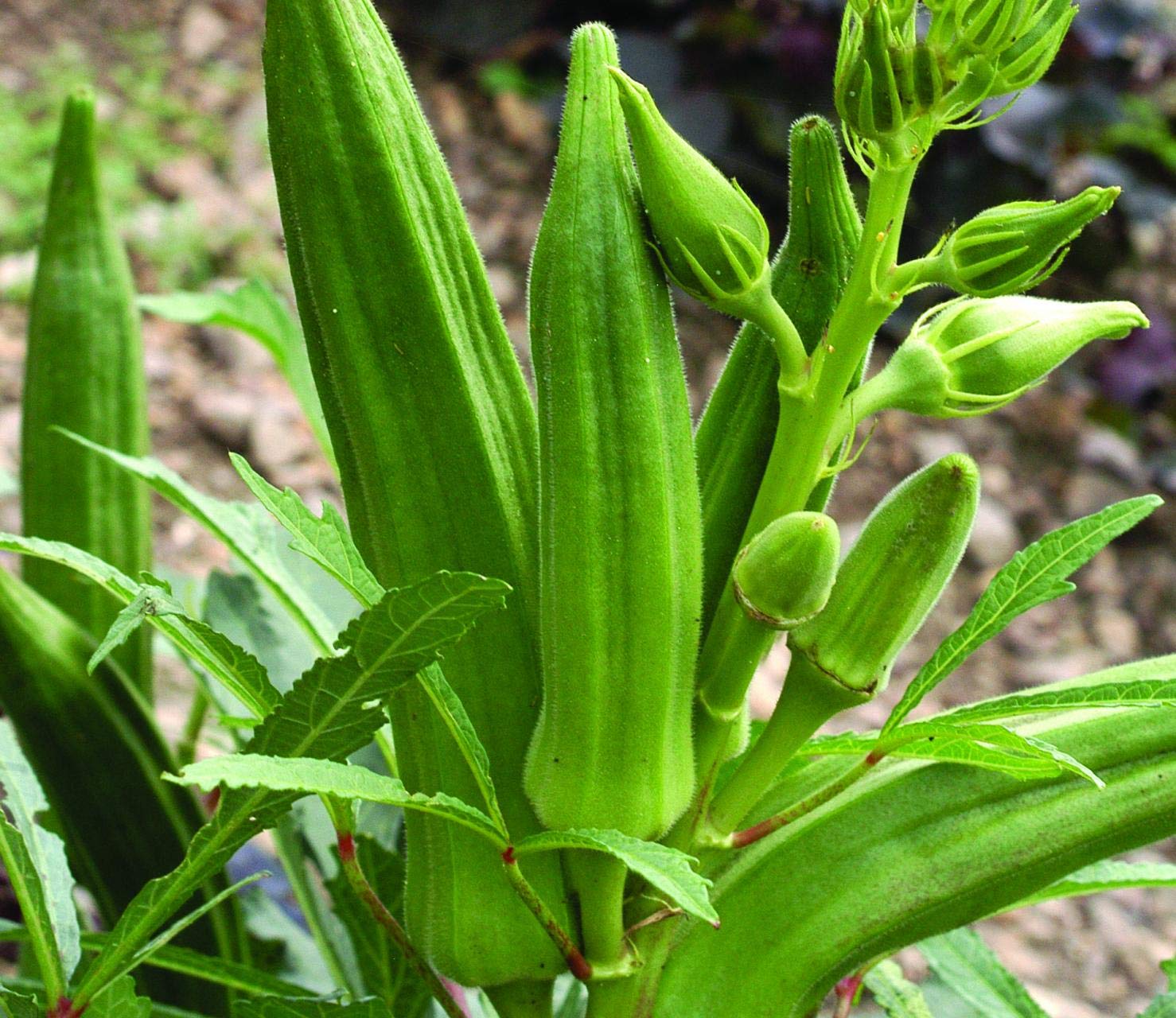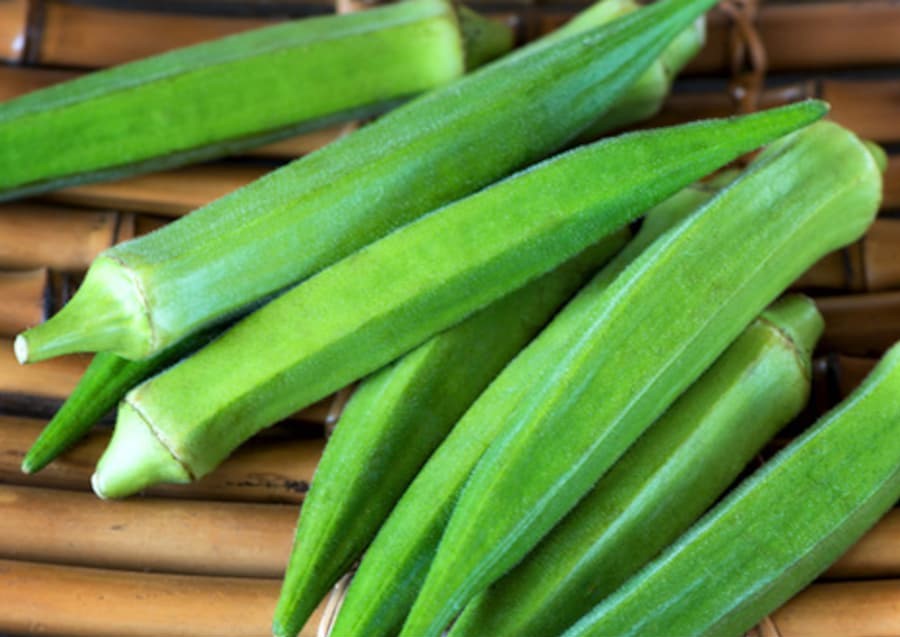

Abelmoschus esculentus (L.) Moench
|
Okra belonging to the family of Malvaceae is commonly known as Bhindi. It is rich in vitamins C and K1. Usually immature fruits of okra are consumed as vegetables and are great for regulating blood sugar level. Quercetin, Quercetin-3-O-gentiobiose and Isoquercitrin are the bioactive compounds present in it. It reduces high blood cholesterol and thereby decreases the chance of heart disease. A water-soluble polysaccharide (OFPS11) found in okra flowers enhanced the phagocytic ability and induced the elevation of Nitric Oxide (NO) production, TNF-α and IL-1β secretion of RAW264.7 cells. Further, RAW264.7 cells while pretreated with OFPS11 decreased the proliferation of HepG-2 cells. OFPS11 exhibited antitumor activity possibly activating macrophage via nuclear NF-κB pathway. Mode of Consumption : Sauteed, fried, boiled and pickled |
| Plant Details | Agro-climatic Zone | Vernacular Names | Pictures |
| Scientific Name: Abelmoschus esculentus (L.) Moench Family: Malvaceae Juss. Class: Magnoliopsida Order: Malvales Genus: Abelmoschus Medik. Fruiting Season: March to August Parts: Fruit, Leaves |
|
Andhra Pradesh : Benda Arunachal Pradesh : Bhindi Assam : Bhendi Bihar : Bhindi Chhattisgarh : Bhindi Goa : Bhindi Gujarat : Bhindi Haryana : Bhindi Himachal Pradesh : Bhindi Karnataka : Vendakkai Kerala : Vendakka Madhya Pradesh : Bhindi Maharashtra : Ram-turai Manipur : Belendri Punjab : Bhindi Rajasthan : Bhindi Tamil Nadu : Ventai Uttar Pradesh : Bhindi Uttarakhand : Bhindi West Bengal : Dhenras |
 Sliced Fruit  Fruit bearing plant  Fruit |
| Compound/Extract | Activity | Mode of Action | Marker/References |
| A. esculentus lectin (AEL) | Anti-tumor | The expression of pro-apoptotic caspase3, caspase-9, and p21 genes was increased along with increase in the Bax/Bcl-2 ratio | Caspase3, caspase-9, and p21 genes, Bax/Bcl-2 ratio [1] |
| Polysaccharide | Anti-tumor | Water-soluble polysaccharide enhanced the phagocytic ability and induced the elevation of NO production, TNF-α and IL-1β secretion of RAW264.7 cells. | NO, TNF-α and IL-1β [6] |
| Fruit powder | Immunoboosting | Dried okra fruit powder supplementation enhances the immune system by increasing the lysozymes and IgM values. | IgM[9] |
| Polysaccharide | Immunomodulatory | Polysaccharides increased cell proliferation, NO production, iNOS expression, and TNF-α, IFN-ϒ, and IL-10 secretion in RAW264.7 cells. | NO, iNOS, TNF-α, IFN-ϒ and IL-10[10] |
| Crude polysaccharide | Immunostimulatory | Crude polysaccharides from okra pods increased the serum level of IFN-γ. | IFN-γ[11] |
| Seed oil | Anti-inflammatory, Antioxidant | Okra seed oil could counteract the injury induced by aspirin via decreasing TNF-α and IL-6, increasing IL-1O in serum, decreasing NO and myeloperoxidase (MPO) and increasing superoxide dismutase (SOD) in stomach. | TNF-α, IL-6, IL-1O, NO, MPO and SOD[12] |
| Water soluble polysaccharide | Anti-tumor | Water-soluble polysaccharide of okra exerts antitumor activity by stimulating macrophage activities through nuclear NF-κB pathway. | NF-κB[17] |
| Crude okra polysaccharide | Immunomodulatory | Increased RAW264.7 cell proliferation, nitric oxide (NO) production, inducible nitric oxide synthase (iNOS) expression, and tumor necrosis factor (TNF)-α, interferon (IFN)-γ,and interleukin (IL)-10 secretion | NO, iNOS, TNF-α, IFN-γ, and IL-10[10] |
| Major Class | Metabolites (Content of bioactives: mg/100g Fresh Weight) |
| Carotenoid | β- Carotene: 29.25 mg/100g[13] |
| Flavonoid | Isoquercitrin: , Quercetin: 2.73 mg/100g, Quercetin-3-O-gentiobiose: [15] |
| Phenolic acid | Protocatechuic acid : 1.27 mg/100g[4] |
| Effect | Observation | DOI |
| In vitro studies | Increase in the count of Lactobacillus rhamnosus and Bifidobacterium longum strains | DOI: 10.1016/j.foodhyd.2021.106779 |
| In vitro studies | Enhanced production of short chain fatty acids (SCFAs) | DOI: 10.1016/j.foodhyd.2021.106779 |
| In vitro studies | Increase in the count of Lactobacillus rhamnosus and Lactobacillus acidophilous | DOI: 10.1016/j.carbpol.2020.116183 |
| In vitro studies | Enhanced production of short chain fatty acids (SCFAs) | DOI: 10.1016/j.carbpol.2020.116183 |
| In vitro studies | Increase in the count of Bacteroides, Phascolarctobacterium, Megasphaera and Desulfovibrio | DOI: 10.1016/j.foodhyd.2020.106577 |
| In vitro studies | Increased production of acetic and propionic acids | DOI: 10.1016/j.foodhyd.2020.106577 |
| Disease | Formulation | Reference | Author | TKDL |
| Information from Wealth of India | Reference |
|
CSIR(1985).The Wealth of India, Raw materials,Revised edition, Vol-V (A), P.-19, New Delhi, India |
| 4.2, 04.2.1, 04.2.1.1, 04.2.1.3, 04.2.2.3, 04.2.2.5, 04.2.2.6, 04.2.2.8 |
| CSIR-North East Institute of Science and Technology, Jorhat-6, Assam, India
CSIR-Institute of Himalayan Bioresource Technology, Palampur-61,Himachal Pradesh, India |